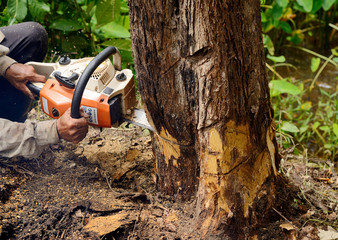Whether you’re dealing with a dead or dying tree or want to give your yard some extra curb appeal, there are several factors to consider when deciding whether to get tree removal services. The species of the tree and how close it is to power lines and buildings can affect whether a tree should be removed or not. You may also want to consider the risks of removing a tree, including falling branches or twigs.

Trees can pose a hazard if they are not removed properly. A falling tree can electrocute a person, or a power wire could come loose and cause an explosion. These accidents can cost a lot of money and life. It is best to hire a professional tree service to avoid this situation. Tree Removal professionals can safely remove dangerous trees and prevent larger problems in the future.
First, you’ll need to check the State and city’s laws regarding tree removal. While there are no specific laws in State, some cities have laws governing the private removal of trees. If your tree is on private property, you won’t need a permit, but you should contact the city for more information on the rules.
If you can’t afford to hire a tree removal service, you can use the timber from the tree instead. This can save the tree removal company a lot of time and money. Many people are willing to pay for tree timber or pick it up for free. You can sell the wood or logs on eBay to make money.
The cost of removing a tree varies considerably, depending on the type of tree. Large trees require heavy equipment and are more difficult to remove. Many other factors can increase the price of a tree removal service. A mature oak tree, for example, costs anywhere from $700 to $1,300 to remove. On the other hand, smaller trees are much cheaper. Small trees, such as hawthorns and silver birches, usually cost between $150 and $500 to remove.
Some cities don’t regulate the removal of trees on private property. However, there are specific municipal codes governing tree removal on public property. So, before you decide to get a tree removed, make sure you know what the city’s laws are about trees. The only exception to this rule is if the tree is hazardous to the public. You must contact the city and ask them for a permit if it is dangerous. The city will also inspect the tree for safety. This can help you avoid a liability lawsuit.
Some states have no specific laws prohibiting tree removal on private property. However, the city has an ordinance requiring a permit to remove trees on larger properties. In addition to obtaining a permit, a company that removes trees will also need to have a plan for replanting the tree once it’s removed. If you cannot obtain a permit, you can be held liable for damages caused by the tree.
The cost of trimming a small tree can vary by twenty to fifty percent. Difficult-access trees may require ropes or other means to lower the branches. These additional labor hours will be reflected in the bill. Trees that are 60 feet or higher will usually cost between $800 and $1,700. Trees more than 80 feet tall will cost anywhere from $1,500 to $3,000 to remove.
A typical cost for tree removal will vary from $385 to $1,070 for a standard project. The cost will also depend on how large the tree is and the size and health of the tree. A large tree will require specialized equipment that can make climbing dangerous, which will add to the overall cost. In addition to a tree removal cost, the costs of hiring a professional tree service can also include the cost of a tree stump, which can range anywhere from $163 to $507 per foot.
Tree removal costs vary greatly depending on the type of tree you’re trying to have removed. The cost will vary according to the size and type of the tree, as well as the location of the tree. In addition, the time of year, accessibility, and other factors will influence the price. Also, the size and number of trunks will affect the cost of the service. These costs are national averages, but local tree care providers will have varying prices.